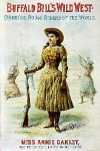 Oakley took up hunting at age nine and soon earned a reputation as a “dead shot.” In her early 20s, she beat marksman Frank Butler in a shooting match and then married him. Together they joined Buffalo Bill’s Wild West Show. Oakley’s famous act included hitting the thin edge of a playing card from 30 paces and shooting targets while looking into a mirror. She was also known for shooting the end off a cigarette held between Butler’s lips, a trick she once performed with what future head of state? Discuss
Oakley took up hunting at age nine and soon earned a reputation as a “dead shot.” In her early 20s, she beat marksman Frank Butler in a shooting match and then married him. Together they joined Buffalo Bill’s Wild West Show. Oakley’s famous act included hitting the thin edge of a playing card from 30 paces and shooting targets while looking into a mirror. She was also known for shooting the end off a cigarette held between Butler’s lips, a trick she once performed with what future head of state? Discuss
Source: The Free Dictionary
 In 1913, DeMille joined Jesse Lasky and Samuel Goldwyn to form the forerunner of Paramount Communications. Their first venture, The Squaw Man (1914), was the first full-length feature film produced in Hollywood. DeMille, known for his flamboyance and his taste for huge casts and extravagant sets, went on to make numerous comedies before creating biblical spectacles such as 1923’s The Ten Commandments. Which of DeMille’s films won an Academy Award for best picture in 1952?
In 1913, DeMille joined Jesse Lasky and Samuel Goldwyn to form the forerunner of Paramount Communications. Their first venture, The Squaw Man (1914), was the first full-length feature film produced in Hollywood. DeMille, known for his flamboyance and his taste for huge casts and extravagant sets, went on to make numerous comedies before creating biblical spectacles such as 1923’s The Ten Commandments. Which of DeMille’s films won an Academy Award for best picture in 1952? 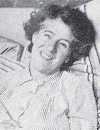 Blyton was a British schoolteacher who began writing in her spare time and went on to become one of the most successful children’s storytellers of the 20th century. She published her first book in 1922 and, over the next 40 years, produced several hundred children’s books and numerous magazine articles. She is best known for several book series, including those featuring Noddy, the Famous Five, and the Secret Seven. Why did BBC radio ban dramatizations of Blyton’s books in the mid-20th century?
Blyton was a British schoolteacher who began writing in her spare time and went on to become one of the most successful children’s storytellers of the 20th century. She published her first book in 1922 and, over the next 40 years, produced several hundred children’s books and numerous magazine articles. She is best known for several book series, including those featuring Noddy, the Famous Five, and the Secret Seven. Why did BBC radio ban dramatizations of Blyton’s books in the mid-20th century?  Shearer, an Academy Award-winning Canadian-American actress, was one of the most popular actresses of the 1920s, 30s, and early 40s. Largely forgotten after her retirement in 1942, she received renewed attention in the 1990s, when some of her films were rereleased. Widely celebrated today as one of cinema’s feminist pioneers, Shearer earned six Academy Award nominations for best actress, winning for her role in The Divorcee (1930). She reportedly passed up a part in what blockbuster film?
Shearer, an Academy Award-winning Canadian-American actress, was one of the most popular actresses of the 1920s, 30s, and early 40s. Largely forgotten after her retirement in 1942, she received renewed attention in the 1990s, when some of her films were rereleased. Widely celebrated today as one of cinema’s feminist pioneers, Shearer earned six Academy Award nominations for best actress, winning for her role in The Divorcee (1930). She reportedly passed up a part in what blockbuster film? 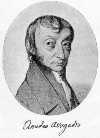 In 1811, Avogadro, an Italian physicist, advanced the hypothesis that equal volumes of gases under identical conditions of pressure and temperature contain the same number of molecules. Now one of the fundamental concepts of the atomic theory of matter, his theory has become known as Avogadro’s law. Since then, physicists have determined the number of molecules in the gram-molecular weight and found that it is the same for all gases. This number, called Avogadro’s number, is how large?
In 1811, Avogadro, an Italian physicist, advanced the hypothesis that equal volumes of gases under identical conditions of pressure and temperature contain the same number of molecules. Now one of the fundamental concepts of the atomic theory of matter, his theory has become known as Avogadro’s law. Since then, physicists have determined the number of molecules in the gram-molecular weight and found that it is the same for all gases. This number, called Avogadro’s number, is how large? 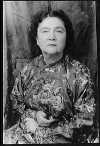 Rawlings was an American author best known for her 1938 novel The Yearling, for which she won a Pulitzer Prize. Rawlings worked as a journalist until 1928, when she moved to the rural Florida backwoods and devoted herself to fiction. There, she incorporated the people and land around her into richly atmospheric works that resemble vivid factual reporting and are noted for their magical descriptions of landscape. The Yearling is about a boy who adopts what animal as a pet?
Rawlings was an American author best known for her 1938 novel The Yearling, for which she won a Pulitzer Prize. Rawlings worked as a journalist until 1928, when she moved to the rural Florida backwoods and devoted herself to fiction. There, she incorporated the people and land around her into richly atmospheric works that resemble vivid factual reporting and are noted for their magical descriptions of landscape. The Yearling is about a boy who adopts what animal as a pet? 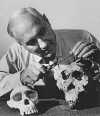 Leakey was a British anthropologist and archaeologist whose work helped establish the course of human evolution in Africa. The son of missionaries, Leakey grew up among the Kikuyu people of Kenya. After attending university in the UK, he returned to E Africa, where he and his wife discovered the first known remains of Homo habilis, an extinct species of hominin widely regarded as the earliest member of the human genus. Who are “Leakey’s Angels,” and what have they gone on to accomplish?
Leakey was a British anthropologist and archaeologist whose work helped establish the course of human evolution in Africa. The son of missionaries, Leakey grew up among the Kikuyu people of Kenya. After attending university in the UK, he returned to E Africa, where he and his wife discovered the first known remains of Homo habilis, an extinct species of hominin widely regarded as the earliest member of the human genus. Who are “Leakey’s Angels,” and what have they gone on to accomplish?  Warhol, one of the most influential artists of the late 20th century, was the leading exponent of the pop art movement. Seeking to minimize the role of his own hand in his work, Warhol began mass-producing silkscreen paintings with the help of assistants at his studio, dubbed “the Factory.” His works, which are both popular and controversial, feature commonplace objects, such as dollar bills, soup cans, and soft-drink bottles, as well as celebrities like Marilyn Monroe. Who shot him in 1968?
Warhol, one of the most influential artists of the late 20th century, was the leading exponent of the pop art movement. Seeking to minimize the role of his own hand in his work, Warhol began mass-producing silkscreen paintings with the help of assistants at his studio, dubbed “the Factory.” His works, which are both popular and controversial, feature commonplace objects, such as dollar bills, soup cans, and soft-drink bottles, as well as celebrities like Marilyn Monroe. Who shot him in 1968? 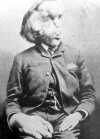 Known as “The Elephant Man,” Merrick was an Englishman who suffered from a severely disfiguring disease, mistakenly thought to have been elephantiasis, that caused growths all over his skin and bone surfaces and made it difficult for him to walk and speak. He escaped from a workhouse at 21 to join a freak show, where he was discovered by a physician who later admitted him to London Hospital. He was cared for there until his death at age 27. What rare syndrome likely caused his deformities?
Known as “The Elephant Man,” Merrick was an Englishman who suffered from a severely disfiguring disease, mistakenly thought to have been elephantiasis, that caused growths all over his skin and bone surfaces and made it difficult for him to walk and speak. He escaped from a workhouse at 21 to join a freak show, where he was discovered by a physician who later admitted him to London Hospital. He was cared for there until his death at age 27. What rare syndrome likely caused his deformities? 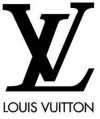 In 1835, Vuitton moved to Paris, where he became an apprentice malletier, or trunk-maker, crafting luggage for the French aristocracy. In 1854, he founded the company that would become a worldwide fashion icon. By 1885, the company had opened its first store in London. He introduced a line of innovative traveling trunks, and his designs soon became the subjects of widespread imitation—a trend that continues even today. What percent of the items bearing the Louis Vuitton monogram are counterfeit?
In 1835, Vuitton moved to Paris, where he became an apprentice malletier, or trunk-maker, crafting luggage for the French aristocracy. In 1854, he founded the company that would become a worldwide fashion icon. By 1885, the company had opened its first store in London. He introduced a line of innovative traveling trunks, and his designs soon became the subjects of widespread imitation—a trend that continues even today. What percent of the items bearing the Louis Vuitton monogram are counterfeit?